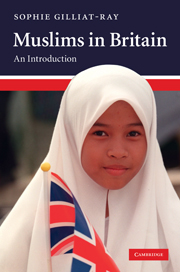Book contents
- Frontmatter
- Contents
- List of figures
- List of tables
- Preface
- Acknowledgements
- List of abbreviations
- PART I HISTORICAL AND RELIGIOUS ROOTS
- PART II CONTEMPORARY DYNAMICS
- 5 Profiling British Muslim communities
- 6 Religious nurture and education
- 7 Religious leadership
- 8 Mosques
- 9 Gender, religious identity and youth
- 10 Engagement and enterprise
- Epilogue
- Appendix: Source notes for researchers
- Glossary
- References
- Index
8 - Mosques
Published online by Cambridge University Press: 05 June 2012
- Frontmatter
- Contents
- List of figures
- List of tables
- Preface
- Acknowledgements
- List of abbreviations
- PART I HISTORICAL AND RELIGIOUS ROOTS
- PART II CONTEMPORARY DYNAMICS
- 5 Profiling British Muslim communities
- 6 Religious nurture and education
- 7 Religious leadership
- 8 Mosques
- 9 Gender, religious identity and youth
- 10 Engagement and enterprise
- Epilogue
- Appendix: Source notes for researchers
- Glossary
- References
- Index
Summary
INTRODUCTION
British Muslims have devoted more energy and resources to the creation of mosques than perhaps to any other institution. There are between approximately 850 and 1,500 mosques in Britain today. They vary considerably in size, architecture, function and history. It is difficult to determine the precise number of mosques because not all premises are registered as places of worship with local authorities, and much depends upon the criteria used to define a mosque. The producers of the ‘Model Mosque’ competition run by the UK-based Islam Channel in 2008 estimated that 1,500 mosques existed in Britain, whereas the Muslim Directory UK 08/09 lists 849 mosques. One academic authority notes the existence of approximately 1,000 mosques, including unregistered premises (McLoughlin 2005b).
It may at first seem rather pointless to try to ascertain precise numbers, but the significance becomes more apparent when the process of establishing a mosque is seen instead as the ‘Islamization of space’ in Britain (Eade 1993). The number of mosques and their location are indicators of broader issues, such as the changing religious landscape of Britain, the degree to which British Muslims are investing in a long-term future in this country, and the scope of Muslims to prevail in their plans with respect to local planning authorities (Gale 2004). This chapter traces the establishment of mosques in Britain from small converted terraced houses to large, purpose-built, multi-functional community centres. Consideration is also given to the internal and external politics that surround mosques.
- Type
- Chapter
- Information
- Muslims in Britain , pp. 181 - 205Publisher: Cambridge University PressPrint publication year: 2010

